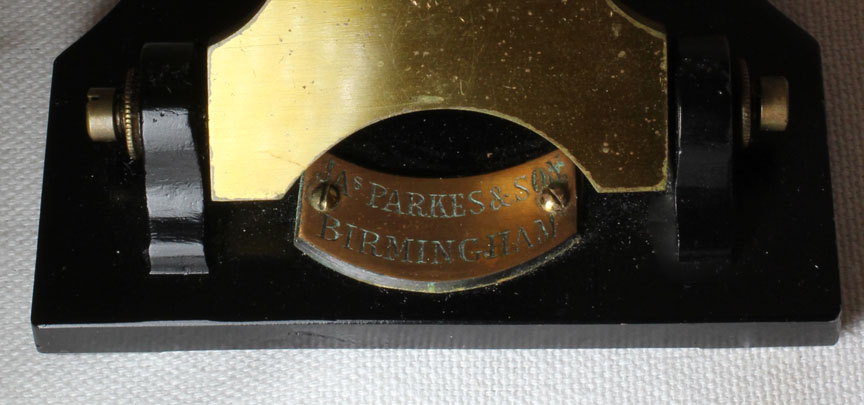| DESCRIPTION | HISTORY |
Please Click On Any Picture for a Larger Version

 This is a fine example of one of the well-made small microscopes marketed by
James Parkes & Son of Birmingham, England in the late nineteenth and early 20th c.
It is signed "JAs PARKES & SON BIRMINGHAM" on the attached brass plate on the foot. The bar-limb construction is supported in the rear by a hinged plate atteched to the foot, and the slots in front into which the limb fits. THere is only a coarse focus by sliding the optical tube in or out. There is no drawtube. The objective is divisible. The stage has two stage clips and is fitted with a wheel of apertures on the underside of the stage. THe mirror is plano on one side and convex on the other smaller side. The gimbaled mirror housing is of lacquered brass, while the gimbal and short swinging tailpiece are of oxidized brass. The finish is mostly painted black with some accents in lacquered polished brass. It came with the
original case, as confirmed by other examples with the same case.
This is a fine example of one of the well-made small microscopes marketed by
James Parkes & Son of Birmingham, England in the late nineteenth and early 20th c.
It is signed "JAs PARKES & SON BIRMINGHAM" on the attached brass plate on the foot. The bar-limb construction is supported in the rear by a hinged plate atteched to the foot, and the slots in front into which the limb fits. THere is only a coarse focus by sliding the optical tube in or out. There is no drawtube. The objective is divisible. The stage has two stage clips and is fitted with a wheel of apertures on the underside of the stage. THe mirror is plano on one side and convex on the other smaller side. The gimbaled mirror housing is of lacquered brass, while the gimbal and short swinging tailpiece are of oxidized brass. The finish is mostly painted black with some accents in lacquered polished brass. It came with the
original case, as confirmed by other examples with the same case.